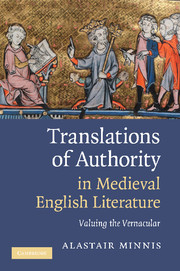Book contents
- Frontmatter
- Contents
- Preface
- List of abbreviations
- Introduction: valuing the vernacular
- Chapter 1 Absent glosses: the trouble with Middle English hermeneutics
- Chapter 2 Looking for a sign: the quest for Nominalism in Ricardian poetry
- Chapter 3 Piers's protean pardon: Langland on the letter and spirit of indulgences
- Chapter 4 Making bodies: confection and conception in Walter Brut's vernacular theology
- Chapter 5 Spiritualizing marriage: Margery Kempe's allegories of female authority
- Chapter 6 Chaucer and the relics of vernacular religion
- Notes
- Bibliography
- Index
Chapter 4 - Making bodies: confection and conception in Walter Brut's vernacular theology
Published online by Cambridge University Press: 30 June 2009
- Frontmatter
- Contents
- Preface
- List of abbreviations
- Introduction: valuing the vernacular
- Chapter 1 Absent glosses: the trouble with Middle English hermeneutics
- Chapter 2 Looking for a sign: the quest for Nominalism in Ricardian poetry
- Chapter 3 Piers's protean pardon: Langland on the letter and spirit of indulgences
- Chapter 4 Making bodies: confection and conception in Walter Brut's vernacular theology
- Chapter 5 Spiritualizing marriage: Margery Kempe's allegories of female authority
- Chapter 6 Chaucer and the relics of vernacular religion
- Notes
- Bibliography
- Index
Summary
Byhold opon Wat Brut · whou bisiliche þei pursueden
For he seyde hem þe soþe · & ʒet, syre, ferþere,
Hy may no more marren [hym] · but men telleþ
Þat he is an heretike · and yuele byleueþ,
And prechiþ it in pulpit · to blenden þe puple;
Þei wolden awyrien þat wiƷt · for his well dedes;
And so þei chewen charitie · as chewen schaf houndes.
(657–63)Thus Pierce the Ploughmans Crede lauds Walter Brut, who has told the friars many home truths about how they have moved far away from Christ's ‘lore and his lawe’. He seems to have been quite a celebrity among the religious dissenters of his day, since he is the only contemporary figure named in this Lollard poem apart from John Wyclif himself. But there is no mention therein of Brut's most radical ideas, including the belief that ‘women have power and authority to preach and make the body of Christ, and they have the power of the keys of the church, of binding and loosing’.
Here I am quoting from the register of John Trefnant, bishop of Hereford, who tried Brut for heresy in 1391–3. It preserves a fascinating series of self-justifications written in Latin by this ‘sinner, layman, husbandman (agricola) and Christian’, as Brut styles himself, adding that he was a Welshman – a fact of which he seems to have been proud, since he explains that both his parents were Welsh.
- Type
- Chapter
- Information
- Translations of Authority in Medieval English LiteratureValuing the Vernacular, pp. 90 - 111Publisher: Cambridge University PressPrint publication year: 2009

